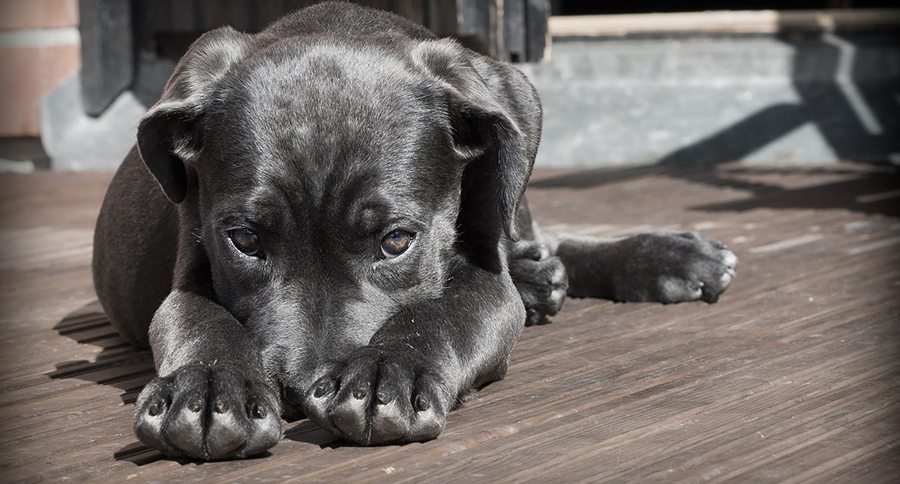While separation anxiety isn’t exclusive to any specific dog breeds, studies suggest that it is more common in some breeds than others.
Like hip dysplasia or stubbornness, separation anxiety isn’t guaranteed for certain dog breeds, but there are breeds that are at higher risk. A dog with separation anxiety exhibits extreme signs of distress that go beyond a mournful whine and a chewed-up shoe. He could chew up an entire sofa, have consistent “accidents” in the house, exhibit excessive barking or howling, get up on window sills and destroy curtains or shades, and if he’s confined to a crate, he could end up hurting himself in an attempt to escape.
Videos by Rare
There is no specific known cause for separation anxiety, but it seems to be more common in breeds known to be “people-dogs” as well as rescue animals. If you’re looking to add a new canine into your life, keep in mind that these six breeds are more prone to separation anxiety than others and could have behavior problems.
1. Labrador Retriever

The Labrador Retriever has long since been known as the American family dog. It may be due to that kind of familial bond that separation anxiety is so common in this breed. They’re loyal and affectionate companions that love nothing more than spending time with their families.
For an unusually high number of Labs, especially young dogs, the trouble starts when the family leaves.
2. German Shepherd Dog

Like the Labrador Retriever, the GSD is found in living rooms and backyards all across the country—not to mention army garrisons and police stations. They’re energetic working dogs with easy temperaments, but recent years have seen more and more cases of separation anxiety.
Along with separation anxiety, the GSD has also seen a recent decline in overall health. It’s unclear whether the two are related.
3. Australian Shepherd Dog

As another active herding breed dog, the Australian Shepherd thrives when there’s a job to do. From herding livestock to working search and rescue, they love being active and getting their paws dirty. They don’t handle boredom well, and that character trait often translates into severe cases of separation anxiety.
They’re happiest when they’re busy, and with no people around, they tend to show signs of extreme distress.
4. German Shorthaired Pointer
 The German Shorthaired Pointer is another working dog but instead of taming sheep, these dogs show their skills on the hunt. They’re one of the most popular hunting dog breeds, and they’re accustomed to working alongside their owners for hours a day.
The German Shorthaired Pointer is another working dog but instead of taming sheep, these dogs show their skills on the hunt. They’re one of the most popular hunting dog breeds, and they’re accustomed to working alongside their owners for hours a day.
They don’t like being left alone, and most would much rather be out in the field with their owner than cooped up in an empty house.
5. Vizsla

The Hungarian Vizsla is another dog bred for the hunt. They form strong partnerships with their owners and are commonly referred to as “velcro dogs.”
When their owners leave, many express their distress with destructive chewing and consistent howling. But when they’re in a duck blind or traipsing through the woods, they’re calm and collected.
6. Bichon Frise

The Bichon Frise is tailored more to being a pampered lap dog than the other breeds on this list, but they’re small dogs with big separation issues. They were bred as companions, and that’s what they do best.
They’re perfectly content to spend every minute with their owners. But when their owners are not in sight, many let panic set in.
It’s important to remember that true separation anxiety can be caused by a number of reasons. The dog could have a history of abandonment or he could have been separated from his mother at too early an age. There are anxious dogs, however, whose separation anxiety seems to come from nowhere.
Pet parents can help ease anxious behaviors by hiring a dog sitter to take them on long walks while you are at work. A tired dog usually doesn’t have time for destructive behavior. Doggy daycare is also a good fix for anxious behaviors because at least they will be supervised and have dogs to play with. Crate training is also useful. The dog needs to learn that it is a safe haven and you need to train your dog into thinking that you will always return. This takes time and lots of good dog training -try using a Kong filled with frozen peanut butter.
These six breeds may be more likely to develop this kind of behavior, but separation anxiety is an affliction that has potential to affect any dog. If your dog is showing signs of severe separation anxiety, it’s important to meet with a canine veterinary behaviorist or certified applied animal behaviorist to learn how to best help your pup overcome his distress and talk about different behavior modifications.
This post originally appeared on Wide Open Pets.



